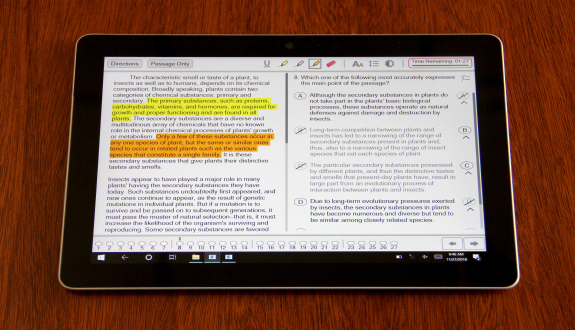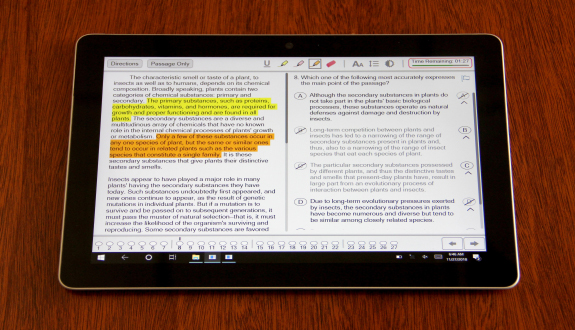Your July 2019 LSAT Instant Reaction
- by
- Jul 16, 2019
- LSAT
- Reviewed by: Matt Riley


Over nine months ago, LSAC announced that the LSAT would officially join the twenty-first century, becoming a digital, tablet-based exam. And today, that finally happened with the July LSAT.
Well, for only about half of all test takers. The exam will finally go digital for all test takers on September 21st. For the July exam, however, LSAC administered the traditional paper-and-pencil test in half of the test centers and then gave the same test in its new digital format to the other centers, in order to compare the results from both formats. This is known as “best testing practices” to the test administrators and “a total pain in the butt” to test takers.
To better understand the new digital LSAT, I came out of test retirement and signed up to take the July exam. Spoiler: I did not receive the digital version of the test. They say 50% of success is just showing up, but since I had a 50% chance of showing up to the location that was administering the digital exam, I suppose this plan had only a … checking my math … 25% chance of success.
But, fortunately, Blueprint’s crack team of LSAT-obsessed employees have been monitoring the experiences of as many people who took the digital exam as possible. With thousands of students to call upon, we were in a unique experience to get some second-hand report about the digital test, even if your faithful correspondent couldn’t provide that first-hand report.
The Digital Experience
So, how did the very first digital LSAT go? In all, relatively smoothly. But it was definitely not without incident. The main complaint is how long it took these test centers to finally get the tablets operational. We’ve heard reports that some proctors had trouble getting the tablets connected to the proctor-controlled motherboard that was used to start and stop each section, which meant that some had to wait almost two hours before the test finally commenced. Some test centers were given tablets that were already circling the drain battery-wise, which led to more wait times as proctors figured out how to charge those tablets. With a completely new format, it’s not exactly surprising that the roll-out wasn’t flawless. Hopefully, by September, proctors will be better equipped to administer the test quickly and seamlessly.
There were also reported issues with the styluses … or is it styli? At any rate, at multiple test locations, test takers were not even given the promised stylus. Someone just forgot about those. Oops. So test takers had to use their sweaty, shaky fingers to highlight and underline the text — which is not ideal, especially when one test taker reported having to use his knuckle to highlight, since his finger was too sweaty to do so.
Others report that the provided stylus wasn’t very good at underlining or highlighting the text — that it would rarely underline just one word, but instead would underline multiple surrounding words. Rather than balling out with the Microsoft-certified stylus made specifically for the Surface Go tablet LSAC is using, LSAC allegedly provided the kind of generic stylus you might get at a work conference or something. Test takers were allowed to keep their apparently not-entirely-effective stylus, though.
There were also reports that glare affected some test takers’ ability to see the screen. Allegedly, the adjustable tablet stand LSAC provided wasn’t quite adjustable enough, and the lighting interfered with test takers ability to see their screens.
Most concerning of all were the reports that at least two test locations had to cancel the LSAT altogether. Apparently, the recalcitrant tablets at these locations refused to work, and after much fussing, the test takers were dismissed without ever taking the exam. I suppose that means they never even got the opportunity to become test takers. Which is a huge bummer for them. Hopefully LSAC allows them to take the test soon, for free, with the option to cancel their score after seeing it, and will maybe wave some law school admission fees for good measure. It will not shock you to learn that both of these test centers were in Florida, incidentally.
And, finally, if you want to get really picayune, Logical Reasoning question stems on the traditional paper version of the LSAT often refer to the “information above,” since that’s where the main text of the question is. On the digital version of the exam, the question still said “information above,” even though the main text is now to the left of the question stem. Maybe that gets corrected in September, when the test is written specifically for the digital version of the test.
OK, you’re probably thinking that I initially said things went “relatively smoothly” but then spent six paragraphs outlining all the ways the test went demonstrably “not smoothly.” That’s a fair observation, but it’s important to remember that people for whom the test goes “not smoothly” are the people most likely to report their experiences. People who felt the digital test went fine wouldn’t need to vent their frustrations, and are hopefully on their third or fourth post-exam elixir at this point. And we heard many reports that the digital exam went well — where test takers had a decent enough time getting through the test, armed with apparently bountiful reams of scratch paper, some commonplace delays notwithstanding.
The July Test
So, with all the reports of the digital exam out of the way, what was the actual content of the test like? This I can provide with first-hand knowledge — this was a hard test! I can also relay some second-hand reports — nearly everyone we’ve heard from shares my sentiment!
Interestingly enough, everyone seems to have gotten a third Logical Reasoning section as their experimental section. Which is annoying, because it make it very difficult to figuring out which two Logical Reasoning were the real, scored sections and which were experimental sections. That said, that’s only a minor annoyance. The only reason you should bother trying to determine which sections were experimental is to figure out whether you should cancel your score. But that’s a moot point for the July 2019 exam. Test takers on this test have the option to cancel their score after seeing it, so there’s no pressing need to make that decision right now. Especially because it’ll take about three fortnights to get your score back.
The three Logical Reasoning questions on my sections included many dense, confusing questions that required you to identify formal aspects of an argument. These sections were also rife with many challenging questions that asked you to change an argument in some way — which has been the case for basically every recent exam. So, you know, normal Monday afternoon reading material.
The Logic Games section was fairly difficult — maybe the most difficult since the notorious-in-LSAT-nerd-circles-at-least December 2017 test. None of the games were totally leftfield, but they were all fairly complicated. The first game looked pretty straightforward — you just had to determine how different departments got arranged in a building — but ended up being quite time-consuming. The second game was one of those games that required a not-in-any-way-obvious deduction to crack things open. Games are never easy, but overall they’ve been more straightforward than these on recent exams. So this section was a bit of an unwelcome surprise.
Not as surprising, but perhaps just as unwelcome, was the difficulty of the Reading Comp section. The second, comparative passage was considered to be one of the most difficult passages here … at least among the top four, according to most.
The Curve Prediction
There’s no reason why you should fret about the curve on a test, especially on a nondisclosed test like July that will not publish the curve. But if fret you must, here’s my take: this exam really reminded me of the December 2017 exam. Except for the Logical Reasoning, which may have been slightly easier than that exam (though it’s admittedly hard to determine that, since we don’t know which section was experimental). I think that the curve of this exam will be forgiving, but not quite as forgiving as that one. Here’s my guess at what the curve will look like:
170: -12
165: -19
160: -27
155: -37
150: -46
(These all reflect how many questions you could miss and earn that score)
Conclusion
First things first, it’s time to accept that the Digital LSAT is here to stay. So, you will need to “digitize” your prep. We don’t expect you to run out and buy a Microsoft Go tablet, but you should be taking digital practice tests. If you don’t know where to find one, get a free tablet LSAT practice test here, or sign-up for a free trial of our Self-Paced course (sidenote: all BP students get access to digital practice tests).
Now, this is the point in these Instant Reaction posts where we talk about whether you should cancel your score, and we, in so many words, say you almost certainly shouldn’t cancel your score. However, for this July exam, you don’t have to worry about that decision now. You don’t have to worry about that decision for a long time, in fact — you’ll get your score back Wednesday, August 28, and you can decide then. So we won’t go through the formality of discussing score cancellation.
Instead, let’s end with a discussion of “difficult” tests like this one. When a test is more difficult than usual, it’s easy to feel utterly defeated. To feel resigned to receiving an underwhelming score. But it’s important to remember that our impressions of our exam performance are frequently unreliable. After an exam, it’s very easy to fixate on what didn’t go well; we rarely, however, remember what did go well. The dark thoughts have a tendency to crowd out the positive ones. And most test takers possess at least a modicum of social grace, so they don’t go around talking about how well they did on the test or how easy parts of it seemed. We overemphasize, both to ourselves and to others, the bad parts of the exam. So our impressions naturally incline us to worry about the worst-case scenario.
With the July exam, you’re going to have to wait a long time to get your score back. You’re going to be left with your thoughts and your LSAT-related conversations for a while — way longer than the usual three weeks. I encourage you to try, as hard as you can, to focus on what went well. Try to crowd out the negative thoughts by concentrating on all the parts of the test that you aced. And, hey, even if your score isn’t quite what you hoped, there’s going to be that voucher to retake the LSAT for free, waiting for you with a press of that “Cancel” button on August 28th. So, don’t wallow on the bad, try to focus on the good.
Or … you know … maybe try to forget about it entirely, perhaps aided by your post-exam beverage of choice. Congratulations, my fellow test takers.
Search the Blog

Free LSAT Practice Account
Sign up for a free Blueprint LSAT account and get access to a free trial of the Self-Paced Course and a free practice LSAT with a detailed score report, mind-blowing analytics, and explanatory videos.
Learn More
Popular Posts
-
logic games Game Over: LSAC Says Farewell to Logic Games
-
General LSAT Advice How to Get a 180 on the LSAT
-
Entertainment Revisiting Elle's LSAT Journey from Legally Blonde








